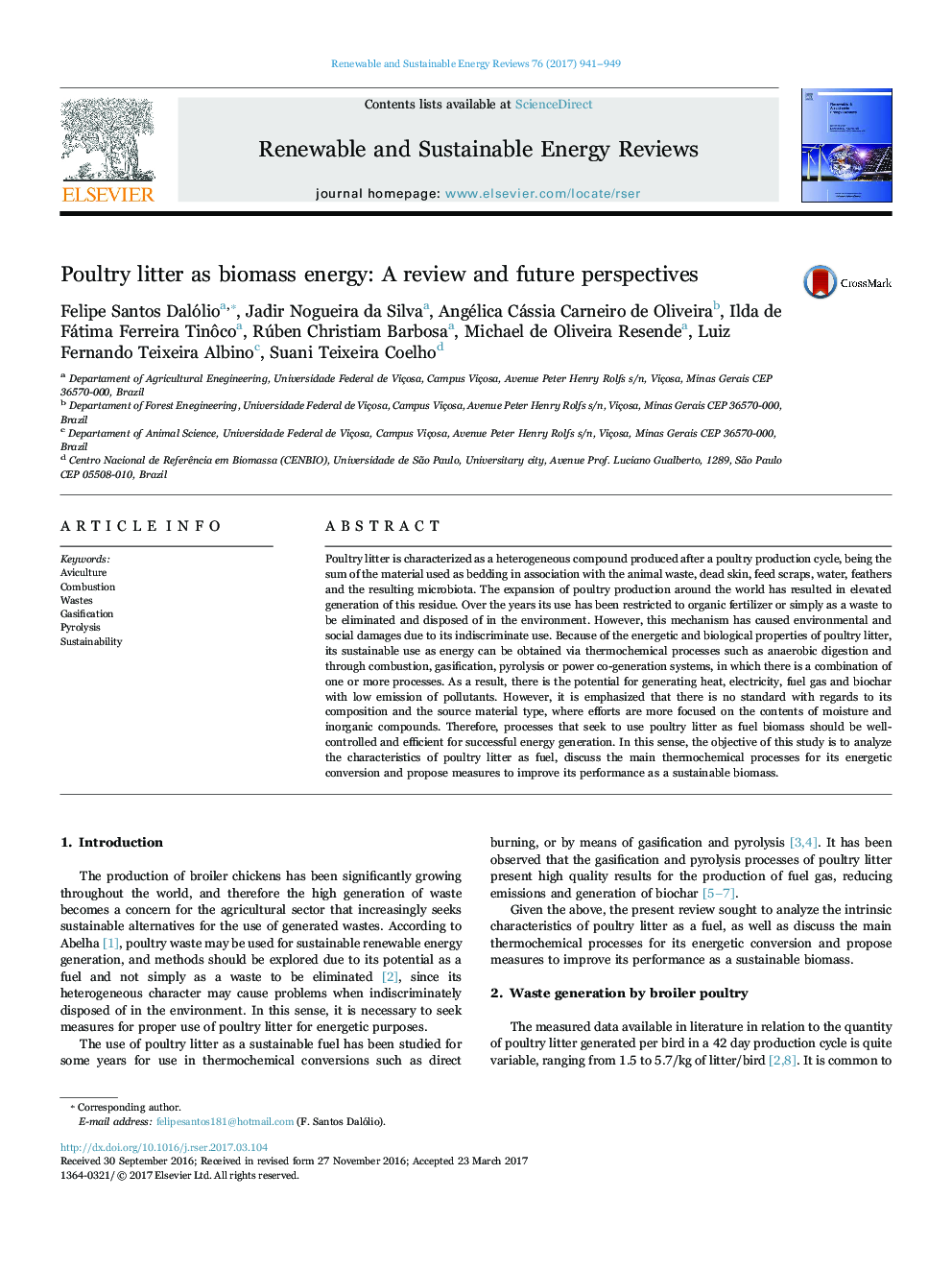| کد مقاله | کد نشریه | سال انتشار | مقاله انگلیسی | نسخه تمام متن |
|---|---|---|---|---|
| 5482203 | 1522310 | 2017 | 9 صفحه PDF | دانلود رایگان |
عنوان انگلیسی مقاله ISI
Poultry litter as biomass energy: A review and future perspectives
ترجمه فارسی عنوان
بستر طیور به عنوان انرژی زیست توده: بررسی و دیدگاه های آینده
دانلود مقاله + سفارش ترجمه
دانلود مقاله ISI انگلیسی
رایگان برای ایرانیان
کلمات کلیدی
مرغداری، احتراق ضایعات، گازسیون، پیرولیز، پایداری،
ترجمه چکیده
بستر طیور به عنوان یک ترکیب ناهمگن پس از یک دوره تولید طیور تولید می شود که مجموع موادی است که به عنوان ملافه در ارتباط با زباله های حیوانی، پوست مرده، خوراکی ها، آب، پرها و میکروبیات تولید می شود. گسترش تولید مرغ در سراسر جهان منجر به تولید بالایی از این باقی مانده است. در طول سالها مصرف آن محدود به کود آلی یا به سادگی به عنوان یک زباله است که باید در محیط زیست حذف و دفع شود. با این وجود، این ساز و کار باعث ایجاد آسیب های زیست محیطی و اجتماعی به دلیل استفاده بی رویه آن شده است. به علت ویژگی های پر انرژی و بیولوژیکی بستر مرغ، استفاده پایدار از آن به عنوان انرژی می تواند از طریق فرایندهای ترمو شیمیایی مانند هضم بی هوازی و از طریق احتراق، گازسیون، پیرولیز یا سیستم تولید انرژی تولید شود که در آن ترکیب یک یا چند فرآیندهای در نتیجه، پتانسیل تولید گرما، برق، سوخت سوخت و زیست تخریب با انتشار کم آلودگی وجود دارد. با این حال، تأکید می شود که با توجه به ترکیب آن و نوع مواد اولیه، که در آن تلاش ها بیشتر بر محتویات رطوبت و ترکیبات معدنی متمرکز است، هیچ استانداردی وجود ندارد. بنابراین، فرآیندی که به دنبال استفاده از بستر مرغی به عنوان سوخت بیوماس سوختی هستند، باید برای تولید انرژی موفق به خوبی کنترل و کارآمد باشند. در این راستا، هدف این مطالعه تجزیه و تحلیل ویژگی های بستر مرغ به عنوان سوخت، بحث در مورد فرآیندهای ترمو شیمیایی اصلی برای تبدیل انرژی خود و پیشنهاد اقدامات برای بهبود عملکرد آن به عنوان یک زیست توده پایدار است.
موضوعات مرتبط
مهندسی و علوم پایه
مهندسی انرژی
انرژی های تجدید پذیر، توسعه پایدار و محیط زیست
چکیده انگلیسی
Poultry litter is characterized as a heterogeneous compound produced after a poultry production cycle, being the sum of the material used as bedding in association with the animal waste, dead skin, feed scraps, water, feathers and the resulting microbiota. The expansion of poultry production around the world has resulted in elevated generation of this residue. Over the years its use has been restricted to organic fertilizer or simply as a waste to be eliminated and disposed of in the environment. However, this mechanism has caused environmental and social damages due to its indiscriminate use. Because of the energetic and biological properties of poultry litter, its sustainable use as energy can be obtained via thermochemical processes such as anaerobic digestion and through combustion, gasification, pyrolysis or power co-generation systems, in which there is a combination of one or more processes. As a result, there is the potential for generating heat, electricity, fuel gas and biochar with low emission of pollutants. However, it is emphasized that there is no standard with regards to its composition and the source material type, where efforts are more focused on the contents of moisture and inorganic compounds. Therefore, processes that seek to use poultry litter as fuel biomass should be well-controlled and efficient for successful energy generation. In this sense, the objective of this study is to analyze the characteristics of poultry litter as fuel, discuss the main thermochemical processes for its energetic conversion and propose measures to improve its performance as a sustainable biomass.
ناشر
Database: Elsevier - ScienceDirect (ساینس دایرکت)
Journal: Renewable and Sustainable Energy Reviews - Volume 76, September 2017, Pages 941-949
Journal: Renewable and Sustainable Energy Reviews - Volume 76, September 2017, Pages 941-949
نویسندگان
Felipe Santos Dalólio, Jadir Nogueira da Silva, Angélica Cássia Carneiro de Oliveira, Ilda de Fátima Ferreira Tinôco, Rúben Christiam Barbosa, Michael de Oliveira Resende, Luiz Fernando Teixeira Albino, Suani Teixeira Coelho,
